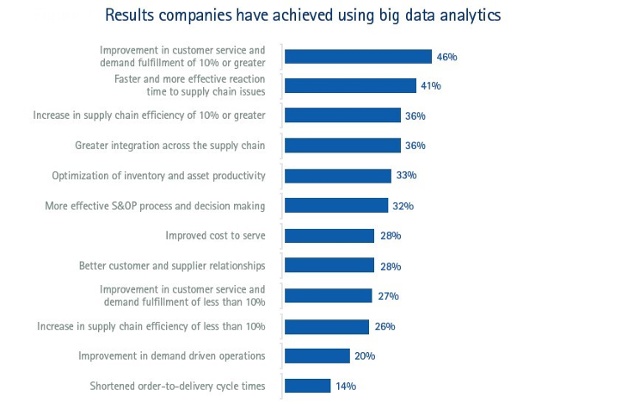The information revolution is giving us a range of logistics management solutions, with massive amounts of data collected by the industry available, but hardly analyzed. One big mistake is to speak in generic terms about Big Data for any industry, instead of looking at its specific applications, for instance in designing and managing the supply chain.
We’ve spoken about how the Internet of Things (IoT) can improve your supply chain.“Big data” itself is a bulk of information with no value unless it’s properly handled. However, its density can overwhelm conventional optimization software. Weather reports, traffic updates, news information, national statistics, fuel price fluctuations have no use unless they are correctly analyzed.
Good fleet management systems and expertise can transform an otherwise inconclusive mass amount of information into trends and indicators which can help in decision making, both in a strategic planning and day-to-day issues.
Descárgate gratuitamente este completo y práctico e-book, que desarrolla como gestionar cualquier flota de vehículos a través de todas sus actividades y factores clave.
According to Louis Columbus, contributor to Forbes Magazine “Big data is providing supplier networks with greater data accuracy, clarity, and insights, leading to more contextual intelligence shared across supply chains.”
Ernesto Goycoolea, Chief Operating Officer for Drivin, has extensive experience in Latin American route optimization. “The use of traffic data obtained from different sources is key to good fleet planning, as it allows us to reduce the number of vehicles used, and alert customers an accurate time of delivery”, he asserts.
A 2014 Accenture Global Operations Megatrends Study reveals that although many companies have high expectations for big data analytics in their supply chain, 97% of its executives have difficulty in its adoption. Only 17% of them report implementing it in one or more functions.
The report suggests that big data and advanced analytics are being integrated successfully as logistics management solutions such as:
- Optimization tools.
- Demand forecasting.
- Integrated business planning.
- Supplier collaboration and risks analytics.
Another significant trend, according to the Boston Consulting Group, is the use of geoanalytics based on big data to merge and optimize delivery networks. For instance, the combination of geoanalysis and big data could help in route optimization, reducing waiting times and driving up service accuracy.
- Visualizing delivery routes: with the use of big data geonalaysis companies can dynamically analyze millions of data points and model hundreds of scenarios to plan a route with multiple stops.
- Pinpointing future demand: nowadays, market demand is volatile and complex. Companies must look at substantial quantities of data from customers, suppliers, and sensors, combining them with weather forecasts, competitive analysis, pricing positions, and other external factors from software that speak different languages, allowing managers to visualize input they couldn’t review before.
- Simplifying distribution networks: the evolution of the supply chain network has evolved into a series of warehouses, factories, and distribution centers. This interrelationship can prove a challenge to traditional logistics management solutions, and big data can help companies solve more complex problems, such as the study of variables and scenarios, and an integrated analysis with interconnected business systems.
Accenture has pinpointed, among the top 5 results companies have achieved with Big Data in a supply chain management process:
- Improvement in customer service and demand fulfillment.
- Faster and more efficient reaction time to supply chain issues.
- An increase in supply chain efficiency.
- Integration across the supply chain.
-
Optimization of inventory and asset productivity.
Challenges to implementation
According to a Deloitte survey, 37% of managers have just “engaged in conversations” to implement analytics. 27% of those who have implemented big data analytics have it operationalized and embedded into critical supply chain processes. However, 57% of respondents use big data as logistics management solutions on an ad-hoc basis.
Some of the main barriers for individual companies are
- Visibility: business logistics experts may have large volumes of data but lack the expertise to see and analyze it as the graphic interface is not user-friendly.
- Volume: the amount of high quantities of data is still something that needs development in small economies and regions like Latin America, the volume of patterns are available in an urban area or a metropolitan region, but are scarcer in forecast traffic in rural areas. With third party companies, it’s easier to create synergies and economies of scale with big data information. Otherwise, the individual in-house use of big data is not cost-effective.
- Use: people may have access to data but don’t know how to give them direction in terms their desired outcomes, strategic and day-to-day orientations. In other words, managers have massive amounts of information available, but don’t know what to do with it.
There is little consensus on how to develop, structure and deploy capabilities key to supply chain efficiency. Accenture sums up three big challenges:
- An active enterprise-wide analytics strategy.
- Ensuring analytics are embedded in supply chain operations
- Working with people with a range of analytic skills and knowledge of the business to produce actionable insights.
Have you used big data for your company? What are the main outcomes and challenges in its implementation? I appreciate your comments below.





 Writen by Francisca Howard
Writen by Francisca Howard